AGE CONC RN?
Page 30
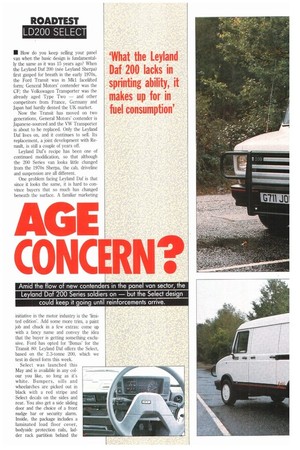
Page 31
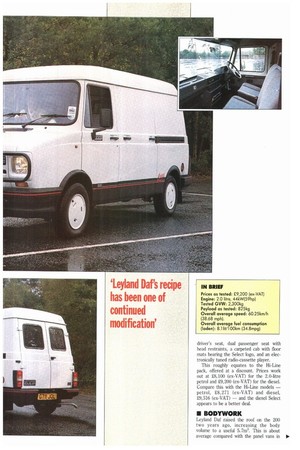
Page 32
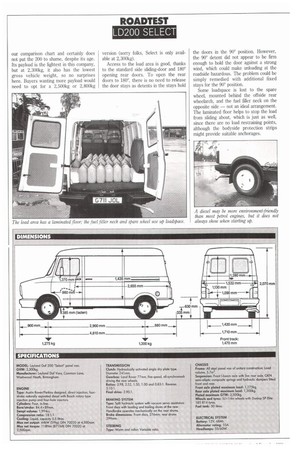
Page 33
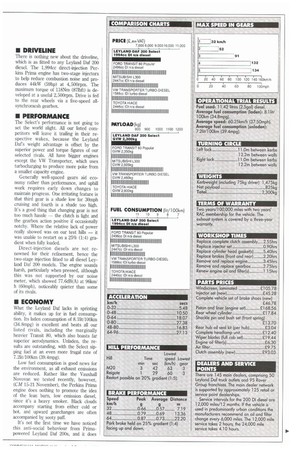
Page 34
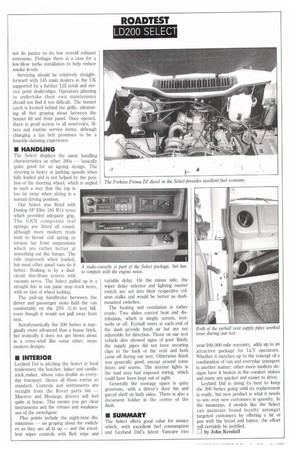
If you've noticed an error in this article please click here to report it so we can fix it.
• How do you keep selling your panel van when the basic design is fundamentally the same as it was 15 years ago? When the Leyland Daf 200 (née Leyland Sherpa) first gasped for breath in the early 1970s, the Ford Transit was in Mkl facelifted form; General Motors' contender was the CF; the Volkswagen Transporter was the already aged Type Two — and other competitors from France, Germany and Japan had hardly dented the UK market.
Now the Transit has moved on two generations, General Motors' contender is Japanese-sourced and the VW Transporter is about to be replaced. Only the Leyland Daf lives on, and it continues to sell. Its replacement, a joint development with Renault, is still a couple of years off.
Leyland Daf's recipe has been one of continued modification, so that although the 200 Series van looks little changed from the 1970s Sherpa, the cab, driveline and suspension are all different One problem facing Leyland Dal is that since it looks the same, it is hard to convince buyers that so much has changed beneath the surface. A familiar marketing initiative in the motor industry is the 'limited edition'. Add some more trim, a paint job and chuck in a few extras; come up with a fancy name and convey the idea that the buyer is getting something exclusive. Ford has opted for 'Bonus' for the Transit 80: Leyland Daf offers the Select, based on the 2.3-tonne 200, which we test in diesel form this week.
Select was launched this May and is available in any col our you like, so long as it's white. Bumpers, sills and wheelarches are picked out in black with a red stripe and Select decals on the sides and rear. You also get a side sliding door and the choice of a front nudge bar or security alarm. Inside, the package includes a laminated load floor cover, bodyside protection rails, ladder rack partition behind the driver's seat, dual passenger seat with head restraints, a carpeted cab with floor mats bearing the Select logo, and an electronically tuned radio-cassette player.
This roughly equates to the Hi-Line pack, offered at a discount Prices work out at 28,100 (ex-VAT) for the 2.0-litre petrol and 29,200 (ex-VAT) for the diesel. Compare this with the Hi-Line models — petrol, 28,271 (ex-VAT) and diesel, 29,518 (ex-VAT) — and the diesel Select appears to be a better deal.
• BODYWORK
Leyland Daf raised the roof on the 200 two years ago, increasing the body volume to a useful 5.7m3. This is about average compared with the panel vans in I.
our comparison chart and certainly does not put the 200 to shame, despite its age. Its payload is the lightest in this company, but at 2,300kg, it also has the lowest gross vehicle weight, so no surprises here. Buyers wanting more payload would need to opt for a 2,500kg or 2,800kg version (sorry folks, Select is only available at 2,300kg).
Access to the load area is good, thanks to the standard side sliding-door and 180° opening rear doors. To open the rear doors to 180°, there is no need to release the door stays as detents in the stays hold the doors in the 90° position. However, the 90° detent did not appear to be firm enough to hold the door against a strong wind, which could make unloading at the roadside hazardous. The problem could be simply remedied with additional fixed stays for the 90° position.
Some loadspace is lost to the spare wheel, mounted behind the offside rear wheelarch, and the fuel filler neck on the opposite side — not an ideal arrangement. The laminated floor helps to stop the load from sliding about, which is just as well, since there are no load restraining points, although the bodyside protection strips might provide suitable anchorages.
• DRIVELINE
There is nothing new about the driveline, which is as fitted to any Leyland Daf 200 diesel. The 1,994cc direct-injection Perkins Prima engine has two-stage injectors to help reduce combustion noise and produces 44kW (59hp) at 4,500rpm. The maximum torque of 118Nrn (87Ibft) is developed at a useful 2,500rpm. Drive is fed to the rear wheels via a five-speed allsynchromesh gearbox.
• PERFORMANCE
The Selects performance is not going to set the world alight. All our listed competitors will leave it trailing in their respective wakes, because the Leyland Dal's weight advantage is offset by the superior power and torque figures of our selected rivals. All have bigger engines except the VW Transporter, which uses turbocharging to produce more poke from a smaller capacity engine.
Generally well-spaced gears aid economy rather than performance, and uphill work requires early down changes to maintain progress. One irritating feature is that third gear is a shade low for 30mph cruising and fourth is a shade too high. It's a good thing that changing gear is not too much hassle the clutch is light and the gearbox action positive if occasionally notchy. Where the relative lack of power really showed was on our test hills it was unable to restart on a 25% (1:4) gradient when fully loaded.
Direct-injection diesels are not renowned for their refinement, hence the two-stage injection fitted to all diesel Leyland Daf 200 models. The engine sounds harsh, particularly when pressed, although this was not supported by our noise meter, which showed 77.6dB(A) at 96km/ h (60mph), noticeably quieter than some of its rivals,
• ECONOMY
What the Leyland Daf lacks in sprinting ability, it makes up for in fuel consumption. Its laden consumption of 8.11it/100km (34.8mpg) is excellent and beats all our listed rivals, including the marginally heavier Transit 80, which also boasts far superior aerodynamics. Unladen, the results are outstanding, with the Select sipping fuel at an even more frugal rate of 7.21it/1001un (39.4mpg).
Low fuel consumption is good news for the environment, as all exhaust emissions are reduced. Rather like the Vauxhall Novovan we tested recently, however, (CM 15-21 November), the Perkins Prima engine does nothing to promote the idea of the lean burn, low emission diesel, since it's a heavy smoker. Black clouds accompany starting from either cold or hot, and upward gearchanges are often accompanied by sooty puff.
It's not the first time we have noticed this anti-social behaviour from Primapowered Leyland Dal 200s, and it does not do justice to its low overall exhaust emissions. Perhaps there is a case for a low-blow turbo installation to help reduce smoke levels Servicing should be relatively straightforward with 145 main dealers in the UK supported by a further 125 retail and service point dealerships. Operators planning to undertake their own maintenance should not find it too difficult. The bonnet catch is located behind the grille, eliminating all that groping about between the bonnet lid and front panel. Once opened, there is good access to all reservoirs, filters and routine service items, although changing a fan belt promises to be a knuckle-skinning experience.
• HANDLING
The Select displays the same handling characteristics as other 200s — basically quite good for an ageing design. The steering is heavy at parking speeds when fully loaded and is not helped by the position of the steering wheel, which is angled in such a way that the top is too far away when sitting in a normal driving position.
Our Select was fitted with Dunlop SP Elite 185 R14 tyres which provided adequate grip. The GKN composite leaf springs are fitted all round, although more modern rivals tend to favour coil spring or torsion bar front suspensions which are rather better at smoothing out the bumps. The ride improved when loaded, but most other panel vans do it better. Braking is by a dualcircuit disc/drum system with vacuum servo. The Select pulled up in a straight line in our panic stop track tests, with no hint of wheel locking.
The pull-up handbrake between the driver and passenger seats held the van comfortably on the 25% (1:4) test hill, even though it would not pull away from rest.
Aerodynamically the 200 Series is marginally more advanced than a house brick, but ironically it does not get blown about in a cross-wind like some other, more modern designs.
• INTERIOR
Leyland Daf is pitching the Select at local tradesmen; the butcher, baker and candlestickmaker, whose vans double as everyday transport. Hence all those extras as standard. Controls and instruments are straight from the Rover parts bin — Maestro and Montego drivers will feel quite at home. This means you get clear instruments and the virtues and weaknesses of the switchgear.
Plus points include the night-time illuminations — no groping about for switches as they are all lit up — and the excellent wiper controls with flick wipe and variable delay. On the minus side, the wiper delay selector and lighting master switch are set into their respective column stalks and would be better as dashmounted switches.
The heating and ventilation is rather crude. Two slides control heat and distribution, which is simply screen, footwells or off. Eyeball vents at each end of the dash provide fresh air but are not adjustable for direction. Those on our test vehicle also showed signs of poor finish: the supply pipes did not have securing clips to the back of the vent and both came off during our test. Otherwise finish was generally good, except around some doors and seams. The interior lights in the load area had exposed wiring, which could have been kept out of sight.
Generally the stowage space is quite generous, with a driver's door bin and parcel shelf on both sides. There is also a document holder in the centre of the dash.
• SUMMARY
The Select offers good value for money which, with excellent fuel consumption and Leyland Oafs latest Vancare two year/100, 000 mile warranty, adds up to an attractive package for LCV operators. Whether it matches up to the concept of a combination of van and everyday transport is another matter: other more modern designs have it beaten in the comfort stakes and many are quicker and easier to drive.
Leyland Daf is doing its best to keep the 200 Series going until its replacement is ready, but new product is what it needs to win over new customers in quantity. In the meantime, if models like the Select can maintain brand loyalty amongst targeted customers by offering a bit of jam with the bread and butter, the effort will certainly be justified.
0 by John Kendall












































































